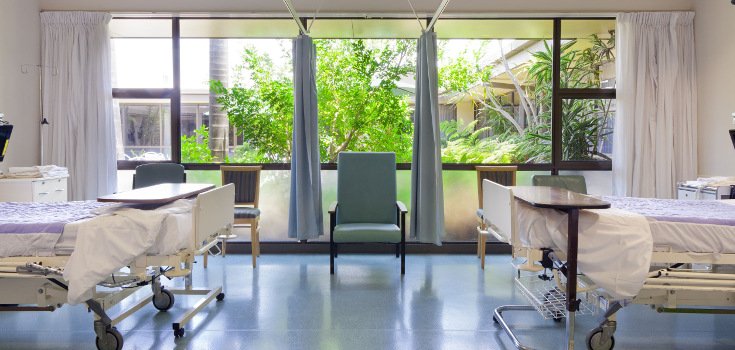PHD Study: Nature ‘Significantly’ Helps in Overcoming Disease

A study by Roger Ulrich, Ph.D. points out that attention to architectural details in a hospital setting, including building in elements of the natural environment, very significantly impact healing outcomes for patients. This includes having appropriate art, soothing music, and having plants around for a natural naturistic healing boost.
If you’ve ever had to stay in a hospital for any length of time, you can likely remember the agonizing blandness of those four white or grey walls, accompanied by tasteless curtains and a dreary window that often looks out over a parking garage or another building in a hospital’s complex. It’s enough to make a sane person crazy.
Form Vs. Function
Not only do more natural architectural details, like huge picture windows that overlook a park or forest, or large French doors that can open to let in an ocean breeze look great, they also add to a psychological peace that is absolutely essential for healing to occur. Even just angling a bed toward a window instead of toward a boring wall can make a huge difference.
Many patients are bed-ridden while staying in the hospital, and although they may want to get out in nature, they are unable to do so. Bringing nature to them, instead, not only soothes their nerves, but also aids in the healing process.
Adding beautiful, soothing music to an environment that pays attention to architectural details is another way to aid in the healing process. Instead of feeling like you are trapped in a mental ward when you have to get a tonsillectomy, you can feel more like you are visiting a spa. Experts in the field of neuroscience have discovered that music boosts mood, which changes how our body reacts to stress, and even ignites some interesting chemical responses to help it fight foreign invaders like viruses and unwanted bacteria.
On the nature-side of things, the American Psychological Association reports:
“In one study, for instance, he asked participants to complete a 40-minute sequence of stroop and binary classification tasks designed to exhaust their directed attention capacity. After the attentionally fatiguing tasks, the randomly assigned participants spent 40 minutes walking in a local nature preserve, walking in an urban area, or sitting quietly while reading magazines and listening to music. After this period, those who had walked in the nature preserve performed better than the other participants on a standard proofreading task. They also reported more positive emotions and less anger.
‘These are not spectacular natural environments or horribly oppressive urban environments,’ says Hartig, an associate professor of applied psychology at the Institute for Housing and Urban Research at Uppsala University in Gävle, Sweden. ‘We try to represent typical local conditions, using what’s available to people in the way of places they can enter if they’re feeling stressed and want some relief.'”
Your body responds to the change in environment, and the immune system is boosted, helping you to recover more quickly. Whenever you can, take part in Forest Bathing and feel your health elevate.
Terri Zborowsky, Ph.D. of the Nursing Institute for Healthcare Design says:
“To me optimal healing environments are created when place, people and process come together.”
